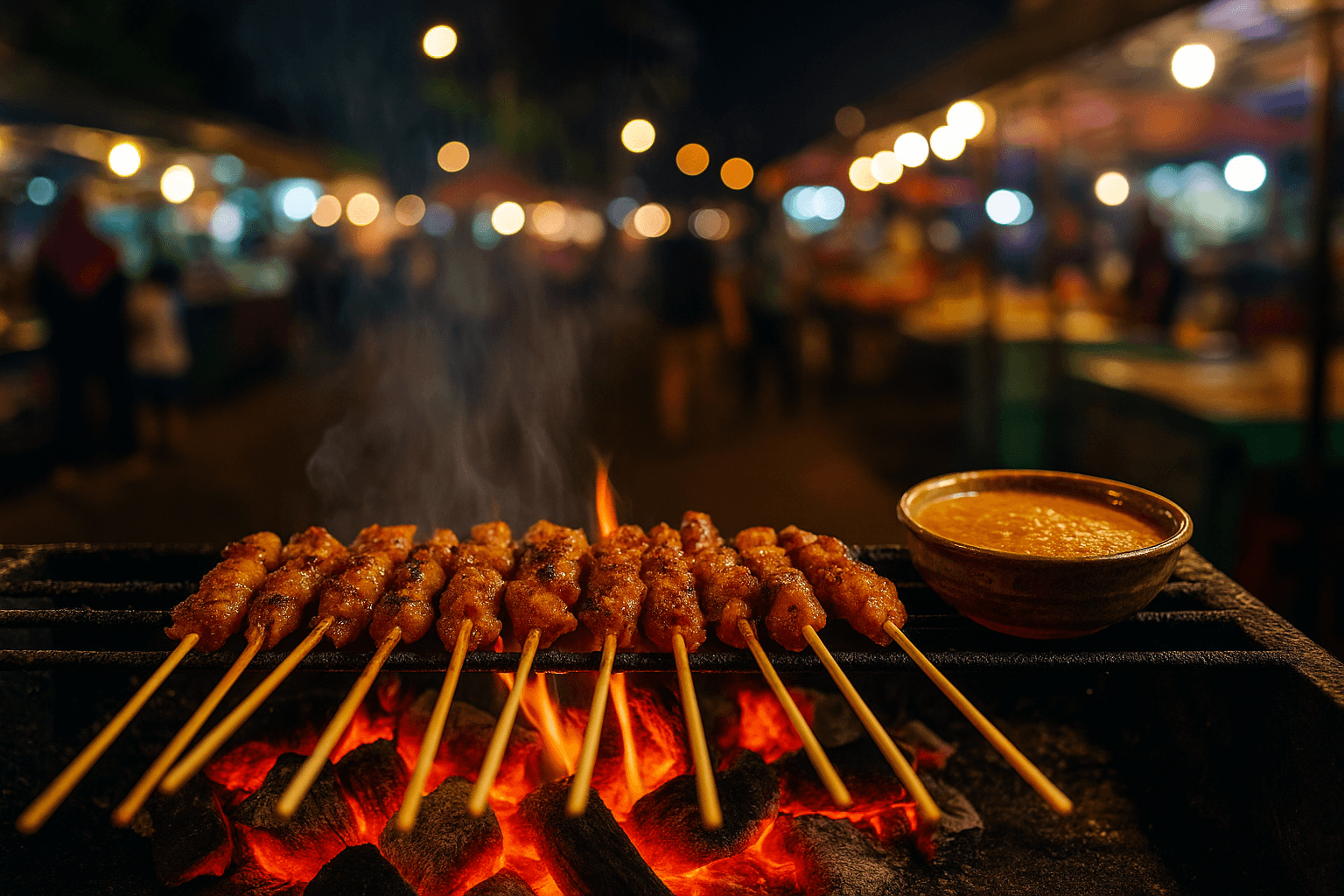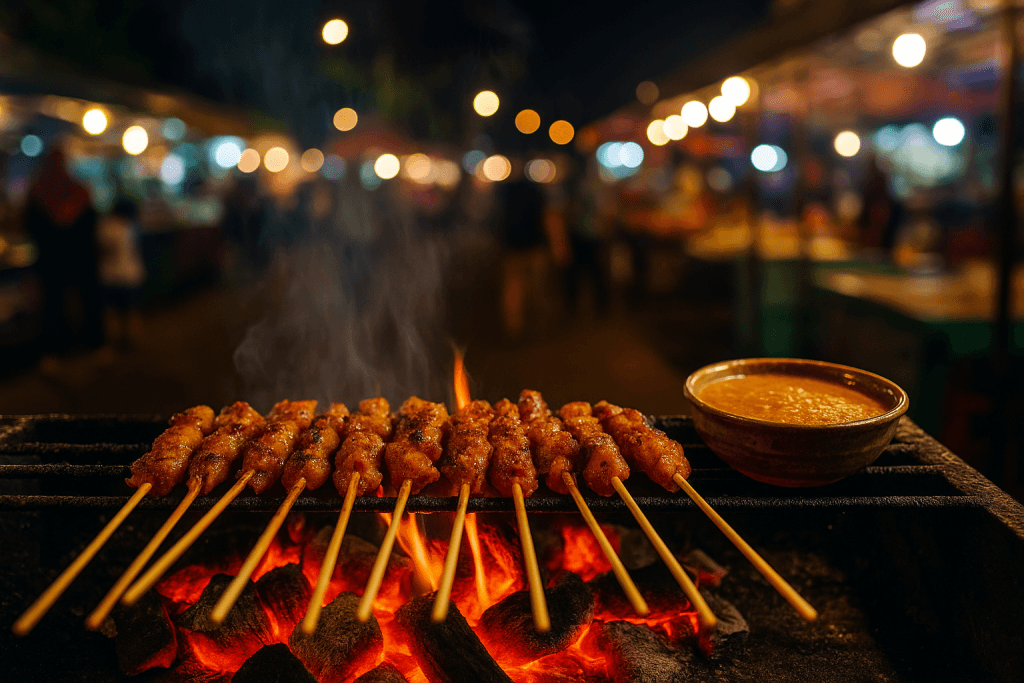When it comes to Southeast Asian cuisine, few dishes captivate the senses like satay. In the heart of Brunei, this traditional food takes on a unique cultural identity, blending flavors, techniques, and community traditions that make it stand out from neighboring countries. Satay Brunei: Skewers of Flavor You Can’t Resist is more than just grilled meat on sticks. It is a symbol of culinary heritage, a reflection of Bruneian hospitality, and an unforgettable experience for anyone who savors authentic Southeast Asian flavors.
Across Brunei’s bustling food stalls, vibrant night markets, and community gatherings, satay is always present. The skewers are prepared with marinated meats, grilled over charcoal, and served with peanut sauce, sambal, or sweet soy dipping. The aromas, textures, and balance of spices embody Brunei’s connection to its Malay roots and Islamic traditions.
This article explores every aspect of Satay Brunei: Skewers of Flavor You Can’t Resist, from its historical background and preparation techniques to the cultural significance and regional variations that shape this beloved delicacy.

The History of Satay in Brunei
The origins of satay can be traced back to the Malay Archipelago, spreading through Indonesia, Malaysia, and into Brunei. Brunei’s version, however, evolved with influences from royal court cuisine, local spice blends, and the sultanate’s trading connections with China, India, and the Middle East.
In Brunei, satay became more than food; it symbolized gatherings, religious celebrations, and social harmony. The skewers were often prepared for weddings, Eid festivities, and public banquets hosted by the royal family. The dish’s historical role solidified it as a staple in the cultural identity of the nation.
Over centuries, Satay Brunei: Skewers of Flavor You Can’t Resist preserved its authenticity while adapting to modern tastes, balancing tradition and innovation.
Ingredients and Marinade Techniques
Essential Components
The core of satay lies in the ingredients. Bruneian satay commonly uses chicken, beef, or lamb, each marinated in aromatic spices. Fish and seafood variations exist along coastal regions.
The marinade typically includes:
Fresh turmeric and galangal for earthy notes
Lemongrass for citrus fragrance
Garlic and shallots for savory depth
Coconut milk for creaminess
Palm sugar for balance
Coriander, cumin, and fennel seeds for subtle spice
The Balance of Flavors
What makes Satay Brunei: Skewers of Flavor You Can’t Resist distinctive is the harmony between sweetness, smokiness, and spice. The coconut milk ensures tenderness, while the charcoal grill enhances the aroma. Bruneian cooks emphasize marination time, allowing the spices to penetrate deeply into the meat.
This process reflects patience and craftsmanship, traits highly valued in Bruneian culinary tradition.
The Art of Grilling Satay
Satay is not complete without the grilling ritual. The skewers are carefully arranged over a charcoal fire, brushed occasionally with oil and leftover marinade. The slow roasting process creates smoky edges while keeping the meat juicy.
Street vendors often fan the flames manually, a performance that attracts customers as much as the fragrance. The sizzling sound and aromatic smoke are integral to the dining experience, transforming ordinary ingredients into irresistible skewers.
In Brunei, grilling satay is an art form. It is about timing, observation, and intuition—skills passed down through generations.
Satay Sauces and Accompaniments
No satay experience is complete without its accompaniments. Satay Brunei: Skewers of Flavor You Can’t Resist shines with its signature sauces and sides:
Peanut Sauce: Creamy, nutty, and slightly sweet, sometimes infused with chili for heat.
Sambal: A fiery chili paste offering a sharp contrast to the richness of the meat.
Sweet Soy Sauce (Kecap Manis): Balances saltiness with caramel sweetness.
Ketupat or Rice Cakes: Compact rice cubes that soak up sauces beautifully.
Fresh Vegetables: Cucumbers and onions provide a refreshing crunch.
Together, these create layers of taste and texture, elevating every bite.
Regional Variations in Brunei
Though Brunei is small, local differences exist in satay preparation:
Bandar Seri Begawan Style: Uses thicker marinades, with peanut sauce served generously.
Tutong Region: Often adds honey or palm sugar for a sweeter glaze.
Belait District: Known for beef satay with smoky, robust flavors.
Temburong District: Sometimes incorporates wild herbs and jungle spices.
These regional touches make Satay Brunei: Skewers of Flavor You Can’t Resist diverse, reflecting local tastes and resources.
Cultural Significance
Satay in Brunei is not just food; it is a cultural emblem. It represents:
Hospitality: Sharing satay at gatherings fosters unity.
Celebration: Weddings, birthdays, and religious holidays often feature satay.
Tradition: Passed down through generations, it connects families to their heritage.
National Identity: While neighboring nations have satay, Brunei’s version reflects its distinct cultural pride.
When people enjoy Satay Brunei: Skewers of Flavor You Can’t Resist, they are partaking in centuries of tradition and community values.
Satay in Modern Brunei
Today, satay thrives in both traditional settings and modern dining culture. Street vendors sell skewers late into the night, while upscale restaurants offer satay with creative twists. Tourism also promotes satay as a symbol of Bruneian hospitality.
In addition, satay is now adapted to healthier lifestyles, with lean cuts of meat, vegetarian options, and less oily marinades. Modern chefs are experimenting with fusion flavors, combining Bruneian satay with global cuisines.
Yet, the core identity of Satay Brunei: Skewers of Flavor You Can’t Resist remains intact—simple, flavorful, and deeply rooted in tradition.
Street Food Culture
Night markets are the heart of Bruneian street food, and satay is always among the highlights. The skewers are displayed on open grills, attracting customers with irresistible aromas. Families, students, and travelers all gather to enjoy affordable, satisfying skewers.
Street food vendors often specialize in satay, passing down family recipes for decades. For many locals, satay is not only a meal but also an expression of daily life and community bonding.
Nutritional Value and Health Aspects
Satay offers a balanced combination of protein, healthy fats, and spices with medicinal benefits:
Turmeric and garlic support immunity.
Lemongrass and galangal aid digestion.
Peanuts provide plant-based protein and minerals.
When grilled properly, Satay Brunei: Skewers of Flavor You Can’t Resist can be a wholesome dish. Modern adaptations also include vegan satay made from tempeh, tofu, or mushrooms, expanding its appeal to diverse diets.
Satay in Celebrations and Festivals
Brunei’s cultural calendar is filled with occasions where satay is essential. During Hari Raya Aidilfitri, satay stalls multiply, symbolizing abundance and joy. At weddings, satay is served as a welcoming appetizer. Community events, school fairs, and charity gatherings often feature satay as a unifying dish.
Its presence at celebrations reinforces satay’s role as both nourishment and tradition, uniting people across ages and backgrounds.
Satay and Tourism
For visitors, experiencing Satay Brunei: Skewers of Flavor You Can’t Resist is a culinary highlight. Tour guides often recommend night markets or famous satay stalls to tourists. Travel blogs frequently mention satay as a must-try Bruneian food.
The dish has become part of Brunei’s soft power, projecting its cultural richness to the world. Culinary tourism thrives on such iconic foods, and satay remains at the center of Brunei’s food identity.
Satay as a Culinary Symbol
Beyond taste, satay symbolizes Brunei’s balance between tradition and modernity, simplicity and complexity. The skewer represents community—small pieces bound together. The grill embodies transformation—raw ingredients turned into irresistible delicacies.
Thus, Satay Brunei: Skewers of Flavor You Can’t Resist is more than food. It is a story of Brunei’s people, values, and place in the global culinary map.
Conclusion
From historical roots to modern street food stalls, from family gatherings to national celebrations, satay is woven deeply into Bruneian culture. Its irresistible flavors, rich sauces, and vibrant presence in daily life make it one of the most iconic dishes of the nation.
When you savor Satay Brunei: Skewers of Flavor You Can’t Resist, you are not just enjoying grilled meat—you are experiencing a living tradition that embodies hospitality, flavor, and cultural pride.
Brunei may be small, but through satay, it has given the world a taste of something extraordinary: skewers of flavor no one can resist.

